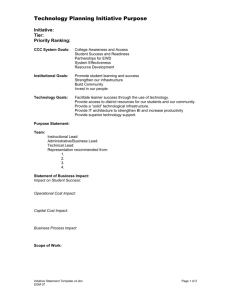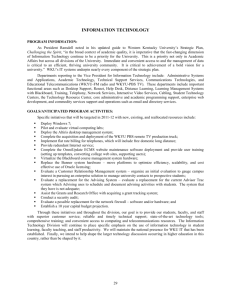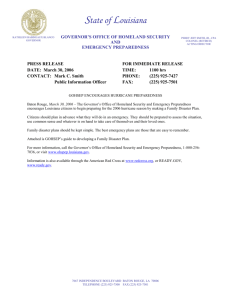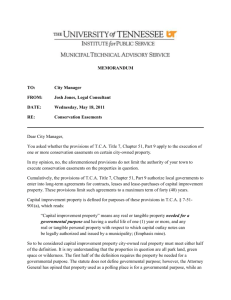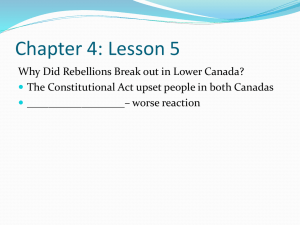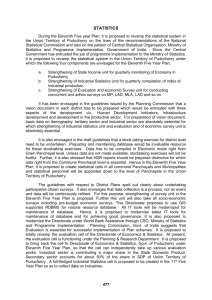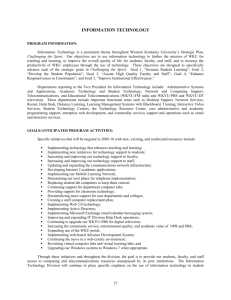Backgrounder - Public Affairs Research Council of Louisiana
advertisement
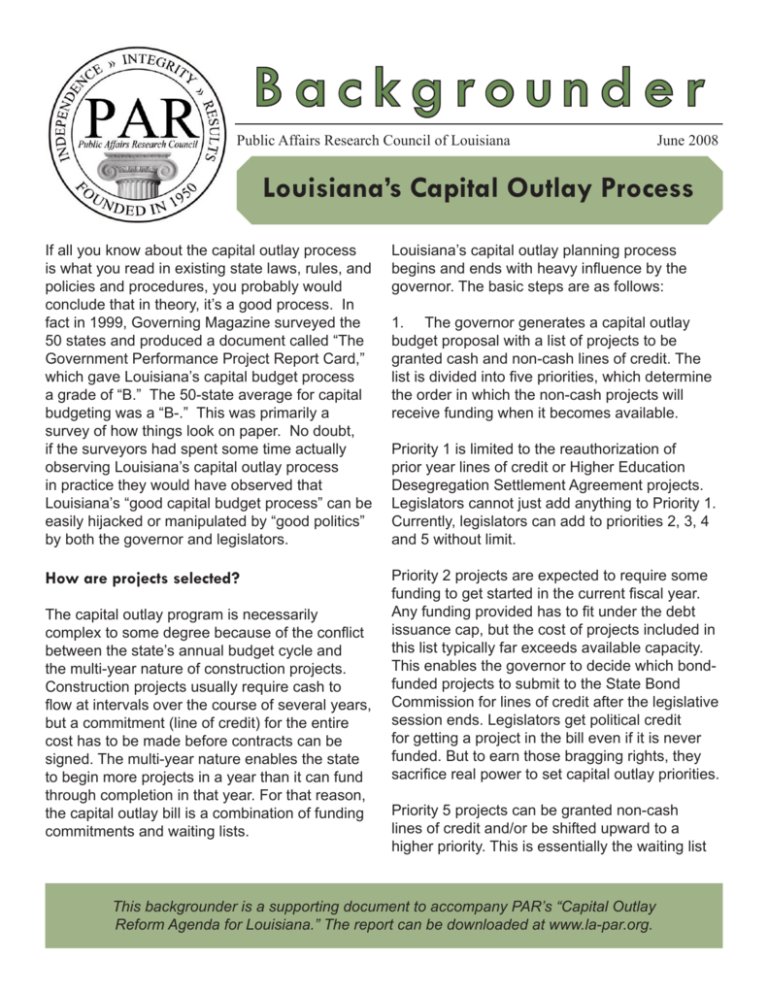
Backgrounder Public Affairs Research Council of Louisiana June 2008 Louisiana’s Capital Outlay Process If all you know about the capital outlay process is what you read in existing state laws, rules, and policies and procedures, you probably would conclude that in theory, it’s a good process. In fact in 1999, Governing Magazine surveyed the 50 states and produced a document called “The Government Performance Project Report Card,” which gave Louisiana’s capital budget process a grade of “B.” The 50-state average for capital budgeting was a “B-.” This was primarily a survey of how things look on paper. No doubt, if the surveyors had spent some time actually observing Louisiana’s capital outlay process in practice they would have observed that Louisiana’s “good capital budget process” can be easily hijacked or manipulated by “good politics” by both the governor and legislators. Louisiana’s capital outlay planning process begins and ends with heavy influence by the governor. The basic steps are as follows: How are projects selected? Priority 2 projects are expected to require some funding to get started in the current fiscal year. Any funding provided has to fit under the debt issuance cap, but the cost of projects included in this list typically far exceeds available capacity. This enables the governor to decide which bondfunded projects to submit to the State Bond Commission for lines of credit after the legislative session ends. Legislators get political credit for getting a project in the bill even if it is never funded. But to earn those bragging rights, they sacrifice real power to set capital outlay priorities. The capital outlay program is necessarily complex to some degree because of the conflict between the state’s annual budget cycle and the multi-year nature of construction projects. Construction projects usually require cash to flow at intervals over the course of several years, but a commitment (line of credit) for the entire cost has to be made before contracts can be signed. The multi-year nature enables the state to begin more projects in a year than it can fund through completion in that year. For that reason, the capital outlay bill is a combination of funding commitments and waiting lists. 1. The governor generates a capital outlay budget proposal with a list of projects to be granted cash and non-cash lines of credit. The list is divided into five priorities, which determine the order in which the non-cash projects will receive funding when it becomes available. Priority 1 is limited to the reauthorization of prior year lines of credit or Higher Education Desegregation Settlement Agreement projects. Legislators cannot just add anything to Priority 1. Currently, legislators can add to priorities 2, 3, 4 and 5 without limit. Priority 5 projects can be granted non-cash lines of credit and/or be shifted upward to a higher priority. This is essentially the waiting list This backgrounder is a supporting document to accompany PAR’s “Capital Outlay Reform Agenda for Louisiana.” The report can be downloaded at www.la-par.org. for future year cash lines of credit. The “overcommitment” problem is here, because the list amounts to a project backlog. Once a project receives a non-cash line of credit it is reasonably assured of eventually being granted full cash line of credit funding in a subsequent fiscal year. projects are granted lines of credit. Language in the capital outlay bill basically says that no lower priority project can be funded with lines of credit unless all higher priority projects are either granted lines of credit or passed over with certificates of impossibility and impracticality. 2. Capital outlay requests are made by state The Interim Emergency Board’s (IEB) role in and non-state entities and submitted to the the capital outlay process, subject to mail ballot governor’s office for inclusion in the bill. The approval by a majority of the Legislature, is Division of Administration has a professional staff to designate a higher or lower bond priority of budget analysts, engineers and architects for projects. Moving funding for a delayed or who participate in a well organized and objective canceled project from Priority 1 down to Priority process for reviewing and 5 can be an alternative categorizing capital outlay to issuing a Priority 1 Louisiana’s “good capital requests to facilitate the certificate of impossibility and budget process” can be easily selection of projects to be impracticality. The IEB also hijacked or manipulated by funded in accordance with the can adjust the description governor’s stated priorities. of a project in the capital “good politics” by both the outlay act to correct, clarify governor and legislators. 3. The governor submits or change the scope of a the capital outlay bill to the description. Legislature. The House Committee on Ways and Means, House Final decisions regarding which projects are Appropriations Committee, Senate Committee on funded are firmly in the hands of the governor. Revenue and Fiscal Affairs and Senate Finance The governor controls project selection at two Committee have jurisdiction over the bill. Projects critical stages: initial development of the annual can be added by the Legislature to priority capital outlay budget and submission of linecategories 2 through 5 regardless of capacity. of-credit requests for bond-funded projects to the State Bond Commission. The governor, 4. The governor has the opportunity to veto the commissioner of administration and the those projects added by the Legislature. governor’s handpicked legislative leaders account for 10 of the 14 Bond Commission 5. The Office of Facility Planning and Control member votes. in the Division of Administration manages the construction projects outlined in the act. Cash In addition, the governor also has line-item veto flow management plays an important role, authority to delete any cash or bond-funded because when projects are delayed or canceled project in the capital outlay budget passed by the for feasibility purposes, cash and non-cash lines Legislature. The process leaves little authority of credit are made available to fund other projects in the hands of the Legislature and essentially in line. The governor recommends projects to the makes the capital outlay bill a legislative wish Bond Commission for funding approval. list for governors to use as a bargaining tool to obtain support for their agenda in other areas of 6. The State Bond Commission’s role is government. to grant or rescind cash and non-cash lines of credit. It also can approve certificates of Governors typically rely heavily on the objective impossibility and impracticality to allow for Priority advice of the Division of Administration 1 projects to be passed over while Priority 2 professional staff in the process of selecting Public Affairs Research Council of Louisiana Page 2 state agency projects for funding, but political percent to 30 percent per year, but in some years considerations are also a major driving factor it has been as high as 40 percent. in the selection of both state and non-state projects. Non-state entities are ports, levee Who supports reform? districts, parish governments, municipalities and other political subdivisions, and In the past 25 years there have nonprofit organizations that been two reform ideas adopted provide a service to the public. While various “reform” that could be called significant Some non-state entity projects improvements to the process. proposals are floated are selected based on their One is the requirement that the every year, this year the merit as infrastructure projects, capital outlay request form be push for change is being economic development projects filled out and submitted prior to or because they are needed embraced by a wider the inclusion of a project in the to protect life and property, but range of stakeholders. capital outlay budget act. The a review of projects funded in other significant improvement Unfortunately, most of the past reveals a long list of was when the administration these approaches appear investments that serve a narrow and the Legislature started to do more to consolidate set of interests with arguably limiting the amount of new cash and strengthen the little regional or statewide lines of credit (new debt) issued impact. These projects often governor’s control over for capital outlay projects in an are treated as rewards for the process than to effect attempt to restrain the state’s legislators who support the per-capita debt load. real reform. governor’s agenda. Why does the state fund nonstate entity projects? The state’s multi-billion dollar backlog of deferred maintenance for highways, higher education facilities and other state buildings continues to grow each year as capital outlay dollars are shared with non-state entities. Non-state entities, especially in rural areas that don’t have a state college, state hospital, state park or major state highway to help generate economic activity, argue that they do not have the ability to generate the revenue to provide for their capital outlay needs. The state Constitution limits local authorities’ revenue generating capacity, which increases the local reliance on state resources. Local and non-governmental projects and programs are funded with both capital outlay dollars and general appropriations via member amendments to the budget bill. At a recent legislative committee hearing, the Division of Administration testified that over the years, the non-state entities’ share of capital outlay funding typically has ranged from 20 While various “reform” proposals are floated every year, this year the push for change is being embraced by a wider range of stakeholders. The governor issued an executive order calling for certain capital outlay reforms and submitted a budget that contained no new projects. In addition, several legislative leaders have put their names on bills seeking various reforms. Unfortunately, most of these approaches appear to do more to consolidate and strengthen the governor’s control over the process than to effect real reform. Public Affairs Research Council of Louisiana Page 3
